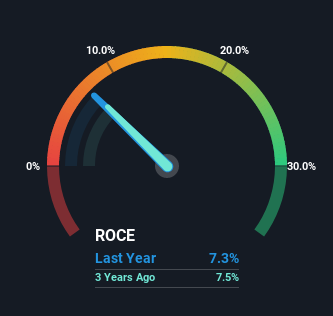- Hong Kong
- /
- Aerospace & Defense
- /
- SEHK:2357
Return Trends At AviChina Industry & Technology (HKG:2357) Aren't Appealing

There are a few key trends to look for if we want to identify the next multi-bagger. Ideally, a business will show two trends; firstly a growing return on capital employed (ROCE) and secondly, an increasing amount of capital employed. Basically this means that a company has profitable initiatives that it can continue to reinvest in, which is a trait of a compounding machine. In light of that, when we looked at AviChina Industry & Technology (HKG:2357) and its ROCE trend, we weren't exactly thrilled.
What Is Return On Capital Employed (ROCE)?
If you haven't worked with ROCE before, it measures the 'return' (pre-tax profit) a company generates from capital employed in its business. To calculate this metric for AviChina Industry & Technology, this is the formula:
Return on Capital Employed = Earnings Before Interest and Tax (EBIT) ÷ (Total Assets - Current Liabilities)
0.073 = CN¥4.8b ÷ (CN¥134b - CN¥70b) (Based on the trailing twelve months to June 2022).
Thus, AviChina Industry & Technology has an ROCE of 7.3%. On its own that's a low return on capital but it's in line with the industry's average returns of 7.0%.
View our latest analysis for AviChina Industry & Technology

In the above chart we have measured AviChina Industry & Technology's prior ROCE against its prior performance, but the future is arguably more important. If you'd like, you can check out the forecasts from the analysts covering AviChina Industry & Technology here for free.
How Are Returns Trending?
The returns on capital haven't changed much for AviChina Industry & Technology in recent years. Over the past five years, ROCE has remained relatively flat at around 7.3% and the business has deployed 82% more capital into its operations. Given the company has increased the amount of capital employed, it appears the investments that have been made simply don't provide a high return on capital.
Another thing to note, AviChina Industry & Technology has a high ratio of current liabilities to total assets of 52%. This can bring about some risks because the company is basically operating with a rather large reliance on its suppliers or other sorts of short-term creditors. Ideally we'd like to see this reduce as that would mean fewer obligations bearing risks.
What We Can Learn From AviChina Industry & Technology's ROCE
In conclusion, AviChina Industry & Technology has been investing more capital into the business, but returns on that capital haven't increased. And investors may be recognizing these trends since the stock has only returned a total of 13% to shareholders over the last five years. As a result, if you're hunting for a multi-bagger, we think you'd have more luck elsewhere.
AviChina Industry & Technology could be trading at an attractive price in other respects, so you might find our free intrinsic value estimation on our platform quite valuable.
If you want to search for solid companies with great earnings, check out this free list of companies with good balance sheets and impressive returns on equity.
New: Manage All Your Stock Portfolios in One Place
We've created the ultimate portfolio companion for stock investors, and it's free.
• Connect an unlimited number of Portfolios and see your total in one currency
• Be alerted to new Warning Signs or Risks via email or mobile
• Track the Fair Value of your stocks
Have feedback on this article? Concerned about the content? Get in touch with us directly. Alternatively, email editorial-team (at) simplywallst.com.
This article by Simply Wall St is general in nature. We provide commentary based on historical data and analyst forecasts only using an unbiased methodology and our articles are not intended to be financial advice. It does not constitute a recommendation to buy or sell any stock, and does not take account of your objectives, or your financial situation. We aim to bring you long-term focused analysis driven by fundamental data. Note that our analysis may not factor in the latest price-sensitive company announcements or qualitative material. Simply Wall St has no position in any stocks mentioned.
About SEHK:2357
AviChina Industry & Technology
Engages in the development, manufacture, and sale of civil aviation and defense products in Hong Kong and internationally.
Excellent balance sheet with moderate growth potential.
Market Insights
Community Narratives



